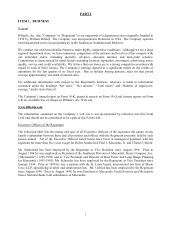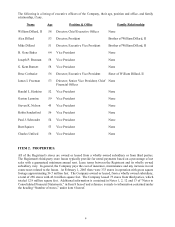Dillard's 2002 Annual Report Download - page 18
Download and view the complete annual report
Please find page 18 of the 2002 Dillard's annual report below. You can navigate through the pages in the report by either clicking on the pages listed below, or by using the keyword search tool below to find specific information within the annual report.stores totaling 434,000 square feet of retail space. The Company closed twelve store locations, including the three
replacement stores, during the year totaling approximately 1.5 million square feet of retail space. Capital
expenditures for 2003 are expected to be approximately $250 million. The Company plans to open five new stores in
fiscal 2003 totaling 773,000 square feet, net of replaced square footage.
The Company recorded a gain of $64.3 million and received proceeds of $68.3 million from the sale of its interest in
FlatIron Crossing, a regional mall in Broomfield, Colorado.
During the year ended February 1, 2003, the Company issued $40 million of variable rate mortgage notes due 2004.
The Company also closed on an additional $200 million in long-term receivable financing and paid off $100 million
in short-term receivable financing bringing the total receivable financing recorded in long-term debt to $400 million.
The Company repurchased $111.9 million of its outstanding unsecured notes prior to their related maturity dates.
The Company also retired the remaining $143 million of its 6.31% Reset Put Securities (“REPS”) due August 1, 2012
prior to their maturity dates. Interest rates on the repurchased securities ranged from 6.13% to 9.50%. Maturity dates
ranged from 2002 to 2028. In connection with these transactions, the Company recorded an extraordinary loss of
$4.4 million (net of income tax benefit of $2.5 million).
In May 2002, the Company amended its conduit financing agreement in a manner that prevented future transfers of
accounts receivable from qualifying as a sale and thus receiving off-balance-sheet treatment. As a result of this
decision, the Company records all financing through this facility on the balance sheet at February 1, 2003 of which
$400 million is classified in long-term debt. At February 2, 2002, the Company had $300 million of off-balance-
sheet financing associated with its securitizations.
Maturities of the Company’s long-term debt over the next five years are $139 million, $207 million, $297 million,
$298 million and $201 million, respectively. The Company may elect to retire $146 million of its 6.39% REPS due
August 1, 2013 in August 2003. The REPS reprice on August 1, 2003 at a rate equal to 5.503% plus the Company’s
trading spread to the ten year treasury note. If the Company elects to call the REPS, the Company will pay a
premium.
During fiscal 2002, the Company closed on a new $400 million revolving credit facility with Fleet Retail Finance,
Inc. (“Fleet”). Borrowings under the facility accrue interest at Fleet’s Base Rate or the Eurodollar Rate plus 1.75%.
The line of credit agreement is secured by inventory of certain Company stores. The agreement expires on May 9,
2005.
The Company was in compliance with all the covenants under the line of credit agreement during fiscal 2002 and at
February 1, 2003. No funds were borrowed under the revolving line of credit during fiscal 2002. At the end of fiscal
2002, the Company had an outstanding shelf registration statement for securities in the amount of $750 million.
In May 2000, the Company announced that the Board of Directors authorized the repurchase of up to $200 million of
its Class A Common Stock. During fiscal 2001, the Company repurchased approximately $22.3 million of Class A
Common Stock, representing 1.3 million shares at an average price of $17.15 per share. Approximately $75 million
in share repurchase authorization remained under this open-ended plan at February 1, 2003.
During fiscal 2003, the Company expects to finance its capital expenditures and its working capital requirements
including required debt repayments and stock repurchases, if any, from cash flows generated from operations. As part
of its overall funding strategy and for peak working capital requirements, the Company expects to obtain funds
through its credit card receivable financing facilities. The Company’s available receivable financing facilities provide
for up to $600 million of which none was outstanding at February 1, 2003. The receivable financing facilities mature
in fiscal 2003. Management expects the $600 million available through its receivable financing facilities to meet
peak borrowing demand. The peak borrowings incurred under the facilities were $465 million during 2002. The
Company expects a comparable level of borrowings during fiscal 2003. The Company intends to renew maturing
receivable financing facilities as they become due. Other than peak working capital requirements, management
believes that cash generated from operations will be sufficient to cover its reasonably foreseeable working capital,
capital expenditure, stock repurchase and debt service requirements. Depending on conditions in the capital markets
and other factors, the Company will from time to time consider the issuance of debt or other securities, or other
possible capital market transactions, the proceeds of which could be used to refinance current indebtedness or other
corporate purposes.
12
























